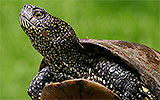Plants and animals
The habitats created by the Danube and its tributaries host a unique mix of species, with about 2,000 vascular plants and more than 5,000 animal species, including over 40 mammals, about 180 breeding birds, obout 100 fish species, a dozen reptiles as well as amphibians.
Did you know?
The Danube River Basin is home for more than 100 different species of fish – including five sturgeon species – and it is home to rare birds like the white pelican, white-tailed eagle or black stork.
The remaining large floodplain forests and the Danube Delta are the last refuges in continental Europe for the white-tailed eagle and the white pelicans. Despite being driven almost to extinction beavers have been successfully reintroduced in the upper and middle Danube.
Changes to the river profile and width, water depth and flow velocity following the construction of dams, dikes, weirs and canals massively disturb the aquatic environment by disconnecting animals from their spawning grounds or otherwise degrading their habitat. Migratory species such as the sturgeons cannot reach their spawning grounds and their habitats in the middle and upper Danube River Basin, due to river continuity and habitat interruption. In a stretch of the River Inn (Germany), for instance, the professional fisheries collapsed after the construction of impoundments at Jettenbach (1921). Today only 2 fish species are able to maintain their stocks by natural reproduction (over 30 fish species before 1921).
Most migratory fish including sturgeons and the Danube Salmon are endangered or close to extinction in the Danube Basin due to habitat loss, habitat degradation and over-exploitation.
River and habitat continuity interruption, as well as the effect on water quality are currently investigated in the frame of the development of the Danube River Basin Management Plan (according to the WFD). A final version of this Plan will be available by end 2009. However, preliminary findings can already be found in the draft Danube River Baisn Management Plan.
Disclaimer
The information contained in the ICPDR website is intended to enhance public access to information about the ICPDR and the Danube River. The information is correct to the best of the knowledge of the ICPDR Secretariat. If errors are brought to our attention we will try to correct them.
The ICPDR, expert group members, nor other parties involved in preparation of information contained on this website cannot, however, be held responsible for the correctness and validity of the data and information provided, nor accept responsibility or liability for damages or losses arising directly or indirectly from the use of the information conveyed therein.
Only those documents clearly marked ICPDR documents reflect the position of the ICPDR.
Any links to other websites are provided for your convenience only. The ICPDR does not accept any responsibility for the accuracy, availability, or appropriateness to the user's purposes, of any information or services on any other website.
When using the information and material provided on this website, credit should be given to the ICPDR.

